On: The Suburban Oversight
4:40 PM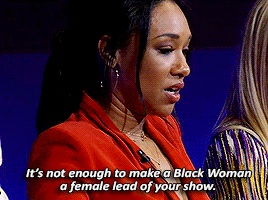

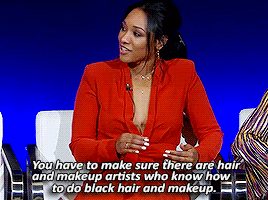
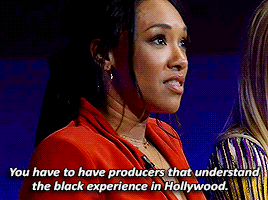
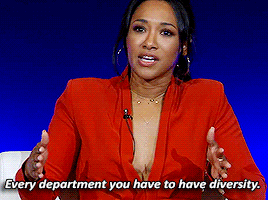

Gifs via iriswestallen
As I meaninglessly scrolled through Twitter last night - dodging porn, unpopular opinions, hot takes and essay-length threads, I came across a query which has remained on the tips of every darkskinned Black girl's tongue for several years:
When it comes to contemporary, popular children's/teen entertainment media - just where are the darkskinned Black girls?
I was born and raised in a wealthy, predominantly white county in the great Yankee-ish state of Maryland. This was not incidental, it was the intentional choice of two Cameroonian immigrants who were firsthand witness to the rise in crime in the District of Columbia metro area. In kindergarten I went to a predominantly Black private school in DC, however due to its distance from my home and the crime rate in the adjoining neighborhood, I was removed after a year.
From first grade to my senior year of high school I went to, arguably, some of the best public schools in my district. Although these schools were predominantly white, they also included a diverse array of children. When I say diverse, I mean DIVERSE - across race, family wealth, ability, sex and gender. By all accounts my county was safe and wealthy, meaning I was privileged to be part of a class of educated Black children who had access to the latest technology, updated books, clean water and freshly paved roads.
To my parents who have worked hard to ensure their children receive only the best so they too became the best, our success was the fulfillment of their choice to live in a very specific area. This, to them, was the practical thing to do as the parents of three Black girls in America.
The thing is, as diverse as each of my schools were, and for as much as white parents boasted of this asset, they were also very self-segregated.
Of course this was of zero concern to my parents - school was for learning, not a fashion show or a social club - but it was something which disturbed me and has, over time, explained a lot about my chosen group of friends, today.
As a first generation Black-American woman, I am not privy to the luxury of being ignorant to the stratification of society. This quickly became evident to me at the ripe age of six.
In elementary school my close group of friends consisted of two lightskinned half-Black girls, a white girl and my very best friend, a darkskinned Black girl. There was no question of why we came together the way we did, but we did. The white girl and my best friend did not end up attending the same feeder-in middle school as me, and since I grew up in an era pre-smartphone and social media, I soon lost touch with them.
By the time I reached middle school, one of my biracial friends leaned towards a group of self-proclaimed book nerds - integrating herself into a crew of white girls who, over time, iced me out for reasons unknown to this day. The other friend was starting to lean towards a crew of girls with whom I was friendly, but was not close friends with. To her credit, she made it a point to encourage me to join her in this new crew of girls which was made up of a white Latina and two darkskinned Black girls. Though I tried, they were just a little too adventurous and raucous for my liking.
So, there I was, the girl who was friendly with everyone, but was not close enough friends with anyone. My lack of 'crew' didn't bother me too much until it was lunchtime - the biggest battlefield the youth will ever face. The time in which loners and friendless dweebs dread most because: when everyone is clustered in a clique, not being in one looks weird. In fear of looking like I was a weirdo, I continued eating lunch with the group of girls who would turn their backs and ignore me when I spoke.
Then came seventh grade, and another K-6 elementary school released into my middle school a new set of children. At this point I had started having lunch with my older-by-one-year sister after she quickly took notice of my feelings of ostracism.
Okay, I complained to her about feeling lonely so frequently she grew tired of hearing it
One of her good friends was part of a crew of girls who were also in my grade level AND new to the school. At that lunch table we quickly we formed our own friend group, a sea of Black girls who moved like a hive. Over time I began to notice that at our unassigned, assigned, extremely long lunch table, were other mini groups of Black or half-Black girls. Strays from cliques that were once diverse in elementary school and sixth grade, but slowly began to fracture once seventh grade hit.
I don't know why it was seventh grade, or what happened to begin these separations once the new kids hit the halls, but it was in that lunchroom that I noticed just how self-segregated my so-called-life was.
Black and brown Latinx kids typically hung out or clustered together, Black girls were ALWAYS in a clique together with maybe one or two brown Latinx girls added to the mix and/or a white girl whose hair was always dyed and pulled up in the tightest bun or ponytail you could conceive, the Asian kids typically exclusively hung out with each other, sometimes with a sprinkling of white and Black guys for diversity, and white kids clustered themselves off with a token Black guy (or two - never three - non-white/white-passing boys) and one lightskinned - often biracial, but may also just be Black - girl with perpetually straightened hair.
That was how the lunch room was set up until I graduated from high school.
And since the seventh grade, my crew of best friends has consisted of those same Black and half-Black women.
The last time I was close friends with a white girl, I was in the eighth grade.
Yes, that means white across ethnicities.
Across ethnic makeup, my group of friends is very diverse. Across race, it is not.
Mind you, I won't apologize for this, for within my friend group exists people I have known since the first grade and freshman year of college. Women who have shown they will have, and have had, my back - no questions barred.
To be frank, only non-white people are tasked with explaining why they do not extend themselves to white people, but I will clarify the lack of non-Black women existing within my close circle is not an intentional choice. It is simply the way the cookie crumbled for me within my specific sphere of lived experience.
So, here's where we get to that representation in entertainment:
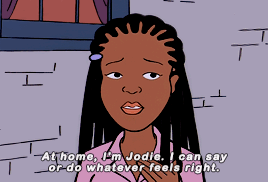


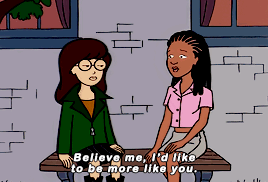
Gifs via jazminesullivan
I believe that most entertainment is a mirror into society. It is not that Black girls who grew up in predominantly white suburbs do not hang out, or are unfriendly, with predominantly white cliques - it is that we are never truly made to feel like a lasting part of these groups. Often we are 'othered' and the darker you are within these suburban enclaves, the higher the chances are of you becoming the targets of casual racism, colorism, sexism and misogynoir. Things which we cannot, and do not, brush off as easily as our Black male counterparts who are seen as being the arbiters of Black cool. As well, past being made to feel as though we are superficial culture token machines, our utility within these groups is never aligned with what one would consider a representation of 'true friendship'.
Per media and my own lived experience, predominantly white subuurban bliss does not account or accommodate for the inclusion of darkskinned Black girls because, according to stereotype, our existence is starkly different from the 'normal Blackness' white people have internalized as coming from Black men and lightskinned Black/half-Black women.
The utility and presence of darkskinned Black women cannot be capitalized upon when you are viewed as an abject obstruction to what white people consider, "Black Cool".
I would like to make clear, when I say Black I mean the offspring of two (see: dos, deux, due, dois) Black parents OR the offspring of one Black parent or one half-Black parent.
These crews are often all white with one or two token male minorities, and one lightskinned Black/lightskinned half-Black girl.
But again: often does not mean ALWAYS.
With thanks to colorism, as true lasting friends we are rarely included in that narrative, however these reflections abandon the actual fact that we exist and move and speak and work and shit and, sometimes, even eat at super long tables together. Neglecting to include darkskinned Black girls within the same environment, neglecting to include the true reflection that groups overlap, is a manifestation of what I call the The Suburban Oversight™.
Today's popular, preteen/teen/young adult entertainment is often showcased through the lens of an individual (usually white) who is telling a story from an experience they are no longer entrenched in (if they were ever entrenched in it to begin with), yet remains distantly familiar. That, my friends, is most often noticeable in the way producers speak about their projects as well as the amount of screen time dedicated to characters, their dialogue and overall costuming. The Suburban Oversight™ limits the perspective of what is seen as 'normal' humanity to white (or white-ish) youth and their smattering of non-white friends with whom they are, kinda sorta, good friends with. Of course, with thanks to casual racism, the non-white friends are rarely given the same justice, screen time, nuanced storylines spanning seasons and not singular episodes, dialogue, depth, fandom engagement, promotion, costuming, adequate makeup artists or hair stylists as their white counterparts, but that they are there at all should appease those of us who know better and want more.
It is not that the people in head offices are unaware of the existence of darkskinned Black girls, after all, when it comes time for a Sapphire, a bully, a 'Jezebel' or a traumatic after school special, there are suddenly a bevvy of them flitting about our screens. The truth of the matter is that telling our normal human experiences in a nuanced way, and making an effort to include accurate cultural perspectives, would require they step outside their bias. It would require an ethnographic-level of care that removes whiteness from the center of Black stories. It would require they interact with entirely new teams of writers, producers, production and development teams, actors, hairstylists, makeup artists, costume designers and social media managers who would be familiar with the fact that, much to the shock and awe or no one: the lives of darkskinned girls in the suburbs are just as mundane and full of teenaged whimsy, experimentation and curiosity, too.
Of course, people are sensitive about their shit, especially when it comes to personal stories. But to limit or even shut out darkskinned girls from fictional narratives is an intentional limitation which much be shamed and called out.
If you look at a one-hundred-year-old predominantly white, wealthy and predominantly white-controlled media industry as though it were a lunchroom in a predominantly white suburban school, you would be able to understand The Suburban Oversight™ with clarity.
It is an experience that does not see the bliss of darkskinned Black girls as a reality or priority because it has iced us out as serving no positive utility to The White (and sometimes even Black) Male Gaze™ with no explanation or reason.
The Suburban Oversight™ is not a standard which was inherent. Like racism and colorism, it was taught, learned, enforced and indoctrinated.
So, no, despite your cries and my own subconscious insistence that I rely on Black, half-Black and/or non-Black content creators to get it right or even do better, there is no guarantee that will be the case.
Since my dawn Earthside, this was once not the case, but now at 24 it has grown to become an issue with which I cannot deny or hide my disappointment.
Especially in an industry that is so self-congratulatory.
I have been conditioned and expected to see and find aspects of myself in non-Black and/or half-Black women. This is not said in complaint or deference of these characters or actors, I am simply able to empathize and recognize the humanity and tumultuous experience of youth in spite of the person onscreen not looking like me. For those blinded, raised and trained by The Suburban Oversight™ well, I am not sure they are capable of doing the same if and when the main girl onscreen actually looks like me.
The Suburban Oversight™ is a crutch that has been leaned on for far too long.
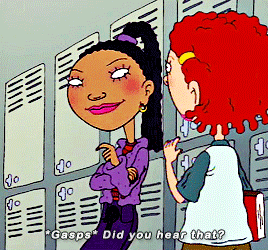

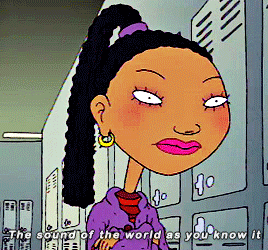

Gifs via jazminesullivan
Instead of asking for a seat or waiting for an invite to the table, we go to our own and receive an inane amount of backlash and cries of prejudice for doing so.
We are always asked to explain our exclusivity to a world that has quickly turned (and will quickly turn) their backs and ignored us until our experiences are explicitly pronounced by joy, love and kinship.
Because it is normal to shut us out and abnormal for us to do the same.
Of course, all skinfolk ain't your kinfolk - loyalty to, and promise for, an imagery of youth without burden or trauma is not guaranteed, rarely well-marketed and often considered unrealistic (which is more parts insulting than part factual even when considering the state of the world), but we deserve that chance.
So, yes, we need darkskinned Black girls to be included in these contemporary children's/teen/young adult media, because ERR, DUH, we exist. Your all white/white-ish fictional utopia is aesthetically boring and unrealistic.
Sorry, your eugenicist vision of the future and reality hasn't panned out the way you thought it would.
It is not enough to rely on The Suburban Oversight™, your media is suffering for it. If you must overhaul your production and development teams to do so, then do so.
Not as an afterthought, not as a response to backlash, but in pursuit of reflections to ACTUAL society.
And a major F* you for not doing this in the first place.
0 comments